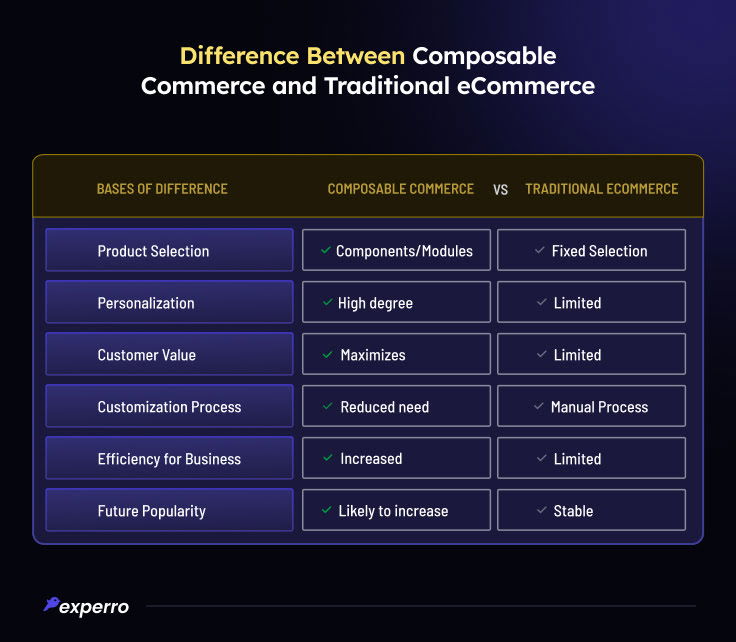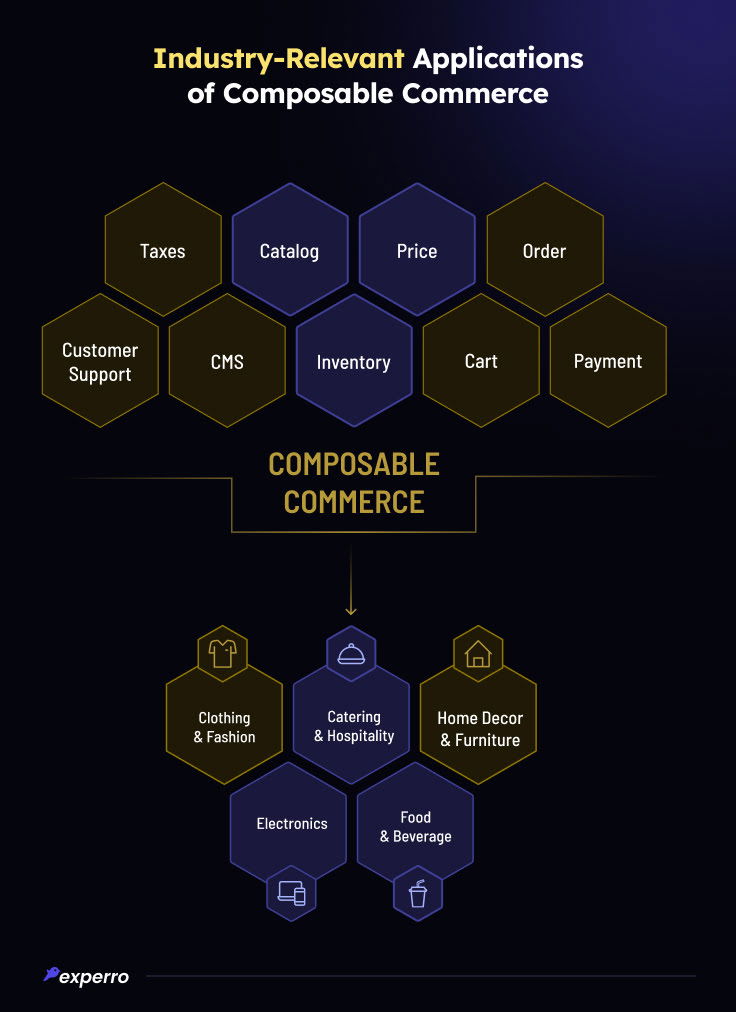What is Composable Commerce - Definition, Architecture, Everything!

What’s Inside
- What is Composable Commerce?
- The Evolution of Composable Commerce
- Composable Commerce: The Future of eCommerce
- Key Features of Composable Commerce
- Benefits of Composable Commerce
- Why is Composable Commerce Rising in Popularity?
- Headless Commerce and Its Relation to Composable Commerce
- Key Differences - Traditional Commerce vs Composable Commerce
- Use Cases of Composable Commerce
- Industry-Relevant Applications of Composable Commerce
- The Integral Role of Modern Technologies in Composable Commerce
- Why Adopt Composable Commerce?
- Challenges and Considerations in Implementing Composable Commerce
- Future Trends & Predictions For Composable Commerce
- Examples in Action
- You must check out Experro and its flexibility before making a final decision!
- Best Composable Commerce Platforms
- How to Choose the Best Composable Commerce Platform
- Want to experience the best composable commerce platform?
- To Conclude!
Key Takeaways
- Composable commerce is a way of selling and consuming products that allow for high levels of personalization and customization.
- It can lead to increased customer satisfaction and loyalty, reduced inventory costs & improved supply chain flexibility.
- AI & ML play a role in composable commerce, including product recommendations, real-time pricing, inventory management & predictive analytics for supply chain management.
- Well-known composable commerce platforms include Experro, Shopify Plus, Magento Commerce, BigCommerce Enterprise, and Salesforce Commerce Cloud.
What is Composable Commerce?
Composable commerce is a modular approach to building and managing digital commerce solutions.
It moves away from the constraints of all-in-one platforms, allowing businesses to craft tailored solutions by integrating the best-of-breed software components.
The Evolution of Composable Commerce
This flexible type of platform did not erupt on its own. Two major aspects caused its existence:
From Legacy Systems to Modular Solutions
The digital commerce landscape has seen a significant shift from rigid legacy systems to more adaptable solutions.
The limitations of traditional platforms lack the flexibility to adapt to rapidly changing market dynamics. This paved the way for the rise of composable commerce.
This evolutionary journey highlights the industry's response to complex business requirements and the need to deliver tailored customer experiences.
Modern Challenges Demand Modern Solutions
The digital age brings new challenges, like higher customer expectations and the need for quick changes. To tackle such advanced needs, businesses needed solutions that were both agile and scalable.
Composable eCommerce, with its modular approach and emphasis on integrating best-of-breed software components, emerged as the answer. It not only addressed the challenges but also set the stage for future innovations.
Having learned its history, let us now go through the future of the eCommerce industry.
Composable Commerce: The Future of eCommerce
In today's rapidly evolving digital landscape, businesses are constantly seeking innovative ways to meet customer expectations and adapt to new business models.
The 'composable commerce', is a cutting-edge approach to digital commerce that not only represents this evolution but also sets the stage for the future.
Key Features of Composable Commerce
Let us take you through the characteristics of composable eCommerce below:
- Flexibility: Unlike traditional eCommerce platforms with a fixed set of functionalities, composable commerce offers the freedom to integrate a variety of components (like CMS or CRM tools).
- Tailored Customer Experience: This approach ensures a more personalized customer journey, catering to specific needs and preferences.
- Rapid Adaptation: Businesses can innovate and adapt faster than ever, ensuring they stay ahead in the competitive market.
Benefits of Composable Commerce
It's time to glance at the good sides of composable commerce:
Increased Customer Satisfaction
With the ability to tailor products or services to their preferences, customers are more likely to be satisfied and loyal to brands offering personalized experiences.
Reduced Inventory Costs
By adopting a composable commerce approach, businesses can reduce excess inventory, as products are often created based on specific customer demands.
Improved Supply Chain Flexibility
Composable commerce allows businesses to adapt swiftly to rapidly changing market dynamics, ensuring that supply chains are agile and responsive.
Enhanced Cross-selling & Upselling Opportunities
With deeper insights into customer preferences, businesses can recommend complementary products, enhancing the overall customer experience.
Why is Composable Commerce Rising in Popularity?
The revenue is expected to rise up to US$63.17bn by 2023. Surprised at the figure?
Well, there are multiple reasons that this concept has gained popularity among entrepreneurs recently:
Limitations of Legacy Systems
Traditional commerce systems, while effective in their time, have shown limitations in today's fast-paced digital environment.
Their rigid structures can impede businesses from swiftly adapting to the intricate business requirements and ever-evolving customer expectations.
Modern Technological Advancements
Composable commerce, with its modular nature, leverages modern technologies like MACH architecture and API-first solutions.
These technologies not only offer flexibility but also ensure that the commerce system is future-proof, ready to adapt to new market trends and innovations.
Business-centric Solutions
One of the standout features of composable commerce is its ability to be business-centric.
Instead of fitting a business into a predefined mold, composable commerce allows the business to shape its commerce solution, ensuring it aligns perfectly with its unique needs and goals.
Headless Commerce and Its Relation to Composable Commerce
While headless commerce focuses on the separation of the frontend and backend, composable commerce takes it a notch higher.
It emphasizes the integration of multiple independent components, ensuring a holistic solution that's both flexible and robust.
The Role of Packaged Business Capabilities (PBCs)
Central to composable commerce is the concept of Packaged Business Capabilities (PBCs).
These are the foundational building blocks that allow businesses to design their unique commerce solution.
Key Differences - Traditional Commerce vs Composable Commerce

Traditional Commerce Platforms: These often present as all-in-one solutions, providing a fixed set of functionalities. While seemingly convenient, they can hinder businesses from swiftly adapting to the ever-changing market dynamics. They are built as per the user's past requirements.
Composable Commerce: This approach champions modularity, enabling businesses to handpick and integrate specific software components that resonate with their distinct business needs. The result? Enhanced customer experiences and the agility to swiftly adapt to market trends and new feature implementations.
| Aspect | Composable Commerce | Traditional Commerce |
|---|---|---|
| Product Selection | Components/Modules | Fixed Selection |
| Personalization | High degree | Limited |
| Customer Value | Maximizes | Limited |
| Customization Process | Reduced need | Manual Process |
| Efficiency for Business | Increased | Limited |
| Future Popularity | Likely to increase | Stable |
Use Cases of Composable Commerce
In this section, we are explaining three different use cases:
1. B2C (Business-to-Consumer)
Companies offering customizable products to end consumers can benefit from composable commerce in various ways.
From clothing and catering to home décor and electronics, companies can use a wide range of customization tools to create unique experiences for their customers.
PLM and PDM tools also help them manage product lifecycles, while CPQ software helps them quickly configure prices.
All these features together make it easier for businesses to respond quickly to customer requests and stay competitive in the market.
2. B2B (Business-to-Business)
B2B companies offering customizable products or services to other businesses can also take advantage of composable commerce.
Companies use product customization tools to give buyers more control over their orders and CPQ software to configure prices for different products or services quickly.
PLM and PDM tools also help them manage product lifecycles and ensure quality control throughout production.
All these features together make it easier for businesses to customize and manage orders quickly, reducing costs associated with fulfilling them and providing buyers with a better experience.
See also - B2B order management made easy with headless CMS!
3. D2C (Direct-to-Consumer)
Companies offering customizable products through their online channels can also benefit from composable commerce.
Product customization tools help them create unique customer experiences, while CPQ software helps them quickly configure prices.
PLM and PDM tools also enable companies to manage product lifecycles better, ensuring quality control throughout production and reducing costs associated with waste management.
Recommended Read - D2C vs B2C eCommerce
Industry-Relevant Applications of Composable Commerce

Multiple industries have accepted Composable Commerce architecture.
They have been integrating various tools such as Product Data Management (PDM), Product Lifecycle Management (tool), and Configure, Price, Quote (CPQ) tools in their workflow.
Take a look!
1. Clothing & Fashion
Clothing companies use product customization tools to create custom designs for customers. From selecting different colors and styles to adding personal touches like embroidery or unique stitching.
They also use product builders to allow customers to assemble their garments from a selection of components. This enables customers to create unique pieces that reflect their personal style.
2. Catering & Hospitality
Companies in the catering and hospitality industry also benefit from composable commerce.
This helps them keep up with customer demand by quickly adapting their menu offerings based on current trends or seasonal changes.
Additionally, companies can use product personalization APIs to allow customers to customize their orders in real-time. This gives customers more control and satisfaction while helping companies manage their inventory levels more effectively.
3. Home Décor & Furniture
For those building a furniture eCommerce website, the home décor and furniture industry is a prime space where composable commerce can be applied.
Companies use product customization tools to allow customers to personalize their furniture with unique fabrics, finishes, and colors.
This helps companies quickly respond to customer requests while reducing costs associated with fulfilling orders.
Additionally, companies can use PLM and PDM tools to track changes in product design and ensure quality control throughout the production process.
4. Electronics
The electronic companies use product customization tools to allow customers to select different colors and styles for their electronics.
They also use CPQ software to configure prices quickly, helping them keep costs down while still providing the best service to customers. PLM and PDM tools also help them manage their product lifecycles, from design to manufacturing through recycling.
This helps companies ensure quality control throughout the production process and reduce costs associated with waste management.
5. Food & Beverage
The food and beverage industry also takes advantage of composable commerce. Companies use product customization tools to allow customers to customize their orders in real-time, giving them more control and satisfaction.
Additionally, CPQ software helps companies quickly manage customer orders and configure prices for different products.
Finally, PLM and PDM tools help businesses stay on top of their product lifecycles, enabling them to manage inventory levels better and improve quality control. This helps companies stay competitive while providing customers with a better experience.
The Integral Role of Modern Technologies in Composable Commerce
It goes without saying that modern technologies have pierced their way through literally everything.
1. Embracing the MACH Architecture
MACH (Microservices, API-first, Cloud-native, and Headless) architecture is a pivotal component of the composable commerce approach.
By leveraging MACH, businesses can ensure a flexible, scalable, and efficient composable commerce platform.
This architecture not only supports the integration of various software components but also aligns with the specific business requirements of modern eCommerce businesses.
2. API-First Approach
In the realm of composable commerce, an API-first methodology is essential.
It ensures seamless communication between different components, be it a content management system, eCommerce platform, or customer relationship management tool.
This interconnectedness is crucial for delivering a cohesive and tailored customer experience in today's digital age.
3. Cloud-Native Solutions
Cloud-native technologies, integral to the composable commerce architecture, offer scalability and resilience.
With the rise of cloud-native SaaS solutions, businesses can swiftly adapt to rapidly changing market dynamics, ensuring they meet customer expectations and stay ahead of the curve.
4. AI & ML

The role of Artificial Intelligence and Machine Learning is as follows:
- Product recommendations and personalized product suggestions
- Real-time pricing and inventory management
- Automated product configuration and customization options
- Predictive customer analytics for supply chain management
Why Adopt Composable Commerce?
Here are a few benefits of adopting composable commerce in your business:
1. Tailored customer experiences: One of the primary benefits of composable commerce is its ability to offer unparalleled customer experiences. By integrating specific software components, businesses can craft a unique commerce solution, ensuring customers interact with a platform that's both intuitive and personalized.
2. Agility and rapid innovation: The modular nature of composable commerce, combined with an API-first approach, ensures businesses can innovate at an unprecedented pace. Whether it's integrating a new feature implementation or adapting to new business models, composable commerce platforms are designed for agility.
3. Cost-effective scalability: Unlike traditional commerce systems, composable commerce allows for targeted scalability. This means businesses can scale specific components of their commerce ecosystem without overhauling their entire tech stack, ensuring cost-effectiveness.
4. Future-proofing the business: The digital commerce landscape is in constant flux. By adopting a composable commerce approach, businesses ensure they're equipped to handle both current challenges and future market shifts.
Challenges and Considerations in Implementing Composable Commerce
Hurdles are everywhere. Here are the challenges that you may come across while executing or using composable commerce:
Understanding the Tech Stack
While the modular approach of composable commerce offers unparalleled flexibility, it also demands a thorough understanding of how it works.
Businesses need to ensure that the software components they select, from content management systems to eCommerce platforms, are compatible and can seamlessly integrate.
This requires technical expertise and a clear vision of the business's unique requirements.
Integration of Multiple Vendors
One of the hallmarks of composable commerce is the ability to integrate best-of-breed components. However, this often means working with multiple vendors.
Ensuring that all the components from different vendors function harmoniously can be challenging.
It's crucial to have a robust integration strategy in place, especially when dealing with essential functions like inventory management or customer relationship management.
Staying Ahead of Customer Expectations
In today's digital age, customer expectations are ever-evolving. With the flexibility that composable commerce offers, businesses have the tools to meet these expectations.
However, it also means that they must be proactive, constantly updating and refining their commerce platform to deliver innovative experiences.
Cost Implications
While composable commerce can be cost-effective in the long run, initial setup and integration might require significant investment. Businesses must weigh the benefits of a tailored composable commerce solution against the initial costs.
Future Trends & Predictions For Composable Commerce
Here's a little sneak peek into what the future with this new-gen tech may look like:
Rise of Headless Architecture
The headless commerce approach, where the frontend and backend are decoupled, is gaining traction.
This trend aligns perfectly with the principles of composable commerce, emphasizing flexibility and the ability to integrate various independent services.
As businesses seek to offer more personalized customer journeys across multiple channels, the adoption of headless architecture is set to rise.
Emphasis On Customer-centric Solutions
As businesses recognize the importance of meeting customer expectations, there will be a shift towards more customer-centric solutions.
Composable commerce, with its ability to tailor the commerce platform to specific business needs, will play a pivotal role in this shift.
Integration Of Modern Technologies
With the continuous advancement of technology, composable commerce platforms will see the integration of newer, cutting-edge technologies.
Whether it's AI-driven customer insights, AR/VR shopping experiences, or cloud-native SaaS solutions, the future of composable commerce is bright and brimming with possibilities.
Examples in Action
1. Nike's customization program: One of the most prominent examples of composable commerce is Nike's "Build Your Own Shoe" initiative.
Through this, customers can start with a base shoe model and then customize it by selecting from various colors, materials for the upper, midsole, and outsole. This level of personalization allows customers to design shoes that perfectly resonate with their style, showcasing the power of composable architecture.
2. IKEA's furniture customization: Another notable example is IKEA's furniture customization. Customers can select furniture pieces and then personalize them by choosing specific colors, fabrics, or designs. This modular approach ensures that customers can create pieces that seamlessly fit into their existing décor, highlighting the benefits of composable commerce.
Best Composable Commerce Platforms
We have handpicked the best composable commerce platforms for you to choose from:
1. Experro: Tailored Flexibility for eCommerce
Experro stands out as a premier composable commerce platform, offering businesses the flexibility to craft a bespoke eCommerce experience. Its core strength lies in its modular design, allowing for the seamless addition or removal of microservices based on evolving business needs. Such adaptability ensures Experro remains resilient to shifting market dynamics.
- Scalability: Designed to manage high traffic, Experro is apt for businesses aiming to expand their digital footprint.
- Feature-Rich: From product catalog management to payment processing, Experro equips businesses with comprehensive tools for a thriving eCommerce venture.
- Industry Recognition: According to a recent Gartner report, modular eCommerce solutions like Experro are pivotal in driving digital transformation, underscoring Experro's position as an industry leader.
In Summary: Experro offers a harmonious blend of flexibility and functionality, making it a top choice for businesses seeking a dynamic eCommerce solution.
2. Shopify Plus
Shopify Plus is a versatile platform catering to businesses of varied scales. It boasts an array of customization tools, from product personalization to advanced analytics.
- Integrated solutions: Shopify Plus seamlessly integrates with third-party services, ensuring a holistic business management experience.
- Decision-driven Analytics: Its advanced reporting capabilities empower businesses with data-driven insights.
In Summary: Shopify Plus presents a holistic composable commerce solution, ensuring businesses remain agile and customer-centric.
3. Magento Commerce
Magento for eCommerce is renowned for its expansive customization tools complemented by integrated third-party services.
- Inventory Mastery: Real-time inventory updates and auto-reordering streamline business operations.
- Customer-Centric: With customer segmentation tools, Magento ensures personalized outreach for enhanced engagement at higher costs.
In Summary: Magento offers a balanced mix of customization and integration, making it a go-to for businesses prioritizing adaptability.
4. BigCommerce Enterprise
BigCommerce Enterprise is tailored for large businesses, offering standard features augmented by unique tools.
- Dynamic Pricing: Automated pricing optimization ensures businesses cater to evolving customer needs.
- Integration Excellence: Its extensive API range facilitates seamless connections with diverse services.
In Summary: BigCommerce Enterprise is the epitome of large-scale composable commerce, offering tools that drive growth and efficiency.
5. Salesforce Commerce Cloud
Salesforce Commerce Cloud is a powerhouse in the composable commerce domain, offering an exhaustive suite of tools.
- Integration Prowess: Seamless connectivity with diverse services ensures a comprehensive business solution.
- Predictive Analytics: Its advanced analytics tools offer foresight, enabling businesses to stay a step ahead.
In Summary: Salesforce Commerce Cloud is the gold standard for businesses aiming for unparalleled digital commerce excellence.
How to Choose the Best Composable Commerce Platform
When selecting a platform for composable commerce, businesses should:
Determine Specific Needs
Understand the unique requirements of your eCommerce business.
Compare Features
Look at the functionalities offered by platforms like Experro, Shopify Plus, and Magento Commerce.
Integration Capabilities
Ensure the platform can seamlessly integrate with other tools and systems you use.
Customer Reviews
Seek feedback from other businesses to understand the pros and cons of each platform.
To Conclude!
Composable commerce is undeniably shaping the future of eCommerce. By allowing unparalleled levels of customization and personalization, it ensures businesses can meet the ever-evolving demands of modern consumers.
As technology continues to advance, the role of composable commerce in defining customer experiences will only become more significant.
Explore Experro to know more!
FAQs


Mehul Shah
25 June 2024A digital marketer with an uncommon funny bone and a knack for perfection, Mehul has been writing about how going headless can help eCommerce stores & businesses for quite some time now! He is a digital marketer and a geek in Inbound marketing who likes to spend most of his time researching ways technology influences your daily life (positively).